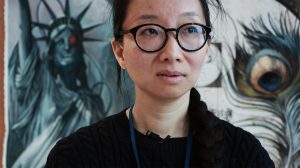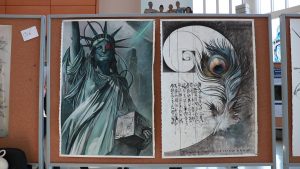Pregraduate conference brings humanities back in the fold

Ada Walman in front of her charcoal installation at the UWill Discover Conference at the University of Windsor. Photo by Bernard de Vaal.
It’s rare that pregraduate students are offered a platform to showcase their research in a conference setting. The UWill Discover Conference! at the University of Windsor changed this for more than 140 student authors.
The 2018 UWill Discover! Conference is a collaborative effort from a host of University of Windsor offices to highlight achievement and discovery in the Windsor-Essex region.
Their aim is to develop student curiosity for research across all disciplines by providing the same presentation and networking opportunities a conventional conference would.
They had three previous conferences dominated by submissions from scientific research efforts. A concerted effort was made this year to draw research from the humanities on a pregrad level by broadening the definition of what defines research.
“Instead of putting out a call for abstracts, we put out a call for submissions,” said Phillipe Wernette, UWill Discover conference chair. “Discovery can take many different forms. It’s not restricted to working one-on-one with the faculty. It can take place in the classroom. It can take place outside of the class room.”
A first for the conference is a unique charcoal arts installation from Ada Walman, a pregrad visual arts student at the university.
Walman completed a three-year course in animation at St.Clair College, but found her passion for working in conventional mediums much more enticing.
Her aesthetic and understanding of Western culture was informed by accessibility to popular culture television and magazines available in China where she was raised.
“The way that I understand the Westerner word (language) is from your movies,” said Walman.
She also draws correlations between the two cultures in one of her works, Golden Section Rectangle.

On the right, Ada Walman’s work “Golden Section Rectangle.” It draws correlations in the universal 1.618 ratio present in natural and aesthetic designs. Photo by Bernard de Vaal.
“From ancient Greece, they have the golden ratio. The golden rule,” said Walden. “The golden rule applies to everything. They apply to the human body. Proportionally. They apply to buildings. They apply to every single thing that appears in our lives.
The Chinese hieroglyphics also has the golden ratio inside. Like the Greek’s ancient buildings.”
As a second-career student, her goals are clear.
“I really need to refresh my mind. To come out. To communicate with this world,” said Walden.
Austin Di Pietro is a final year live jazz student major who presented his research on the effect the Detroit Jazz scene had on developing and influencing the local scene.
“A lot of people don’t really know that Windsor has this jazz scene or this history and it’s really rooted in Detroit,” said Di Pietro. “Some interviews I did really showed that Detroit was a huge influence on Windsor’s music scene.”
Pi Dietro noted a startling revelation in his research was that several local jazz clubs in the 40s and 50s advertised solely to American clientele to bring in customers.
“I didn’t find that the other way around,” said Di Pietro. “The Detroit jazz bars were doing this but not the Windsor ones. There was such a large American clientele because it was considered an American art form.
Using an interactive map, Di Pietro shows the locations of jazz clubs on both sides of the border in the 1940’s and 50s. Strong cultural assimilation took place, because jazz lovers were in walking distance of world-class modern jazz music in Detroit.
Di Pietro feels his research is contributing to the broader Canada-U.S. discourse.
“It’s just incredible to show that this really important cultural scene influenced Canada’s cultural scene and Windsor too,” said Di Pietro.
Wernette felt there still wasn’t a broad enough representation in some fields of study. He aims to address this by extending future conferences to a four-day program.
“We want to highlight undergraduate research, but add a graduateur as well so you have that graduate/undergraduate mentorship possibility,” said Wernette.
If you want to find out more about the event or would like to make a submission for next year’s conference, visit their website.


